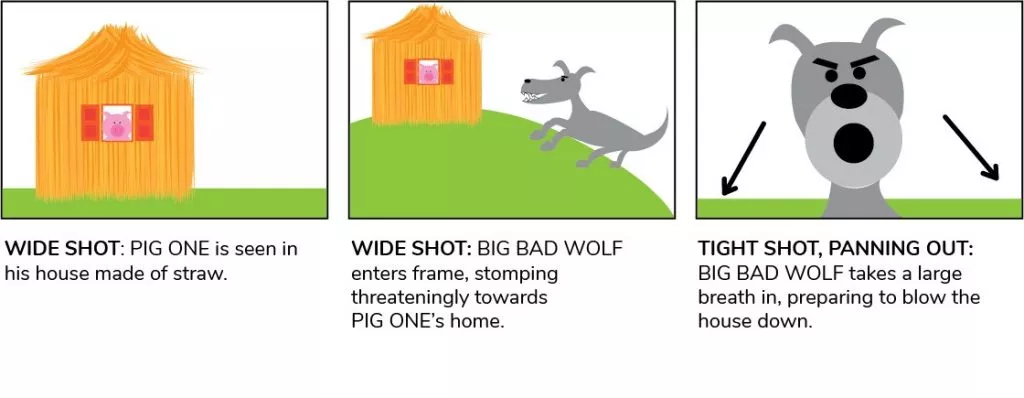Storyboarding Tips for Marketing Videos & Free Storyboard Template
The Best Productions Start with Great Preproduction
Have you ever gone grocery shopping without a shopping list? If you have, you probably know the feeling of walking out with a cart full of food and still forgetting the stuff you really needed.
Filming a video is like making a trip to the grocery store. Your grocery shopping is most successful when you sit down, determine what you’d like to eat, research recipes, evaluate what you already have in the fridge and formulate a carefully organized plan.
Think of a marketing storyboard as your shopping list. With a great storyboard, you’re set up for a successful day of production.
The biggest difference? If you forget an item grocery shopping, you can always run back to the store. But if you miss a shot in your video, you’ve got location, talent, and crew that you’ll need to call back in to get the perfect shot. Follow these storyboarding tips to save money, time, and frustration and create a marketing video storyboard to know what you need before filming.
Get started now and download our free storyboard template.
What Is a Storyboard, Anyway?
Think of a storyboard as a still, chopped-up version of your video. A storyboard for videos relies on a few crucial frames to convey your video’s basic storyline while giving a taste of how your video’s shots will be framed and how the camera will move.
Our video team has plenty of storyboarding tips to help plan your shoot. Effective storyboarding includes:
- Camera/Shot Descriptions (Close Up, Handheld Shot, Wide Shot, etc.)
- Script/Dialogue
- Location
- Action (What’s happening on screen, movement, etc.)
- Transitions
- Music and sound effect descriptions
How to Make a Storyboard that Works for You
Tip #1: Build an Outline
Once you’ve landed on a solid concept, shape your video into a rough outline. A video outline should articulate your video’s overarching plot. Your outline is a brief synopsis of your video—identifying how your story will move from beginning to end. As you tell your story in its most basic form, start to consider how camera placement and movement will enhance your video.
The three little pigs have recently become homeowners. A local menace, the Big, Bad Wolf, comes to pay them a visit. He blows down the first pig’s home, then the second, but the third pig’s home is made of materials too strong for the Big Bad Wolf to threaten, so all three pigs survive, safely within the third pig’s home. Everyone learns a valuable lesson about investing in strong building materials. The End.
Tip #2: Assemble Your Shot List
Next, build a shot list. While an outline is a flowing, contiguous description of your video, a shot list is a play-by-play plan for every shot you plan to get to accomplish your video’s outline, or overarching story.
- Wide shot: PIG ONE is seen in his house made of straw.
- BIG BAD WOLF enters frame, stomping threateningly toward PIG ONE’s home.
- Tight shot panning out as BIG BAD WOLF takes a large breath in, preparing to blow the house down.
- Cut to POV of PIG ONE as he watches BIG BAD WOLF huff and puff from the false security of his straw home.
Tip #3: Your Storyboard
Finally, it’s time to bring your shot list to life with some quick illustrations to help you visualize your video. Use your shot list and your script to guide your storyboard, including a brief description of the frame below your illustration of each shot. You can use a marketing video storyboard template or build your own storyboard marketing layout from scratch.
You don’t need to know how to draw to know how to storyboard a video. It’s more important to get your thoughts down in a way you’ll understand later. Just sketch rough shapes, stick figures, or whatever you feel comfortable with. You’re storyboarding videos for reference, not to put on your portfolio.

Go Ahead, Shoot Outside Your Storyboard
Just because you have a strict shopping list doesn’t mean you can’t grab a candy bar in the checkout lane. There’s no hard and fast rule on how to use a storyboard. Use it as your guide, not your rulebook. While it’s important to get all the shots your storyboard calls for, don’t let a storyboard limit your creativity. As long as you get the shots that you absolutely need, you’ll never regret getting bonus footage.
Get a Fresh Perspective with Professional Videography
There’s a lot of freedom and creativity that comes with producing marketing videos. Our video team offers effective, impressive video content that’s designed for multiple applications. Get more out of every video project with cut-to-order YouTube, social media, commercial and other assets. Let’s get rolling; reach out or call (231) 922-9977 to see what our team can create for you!